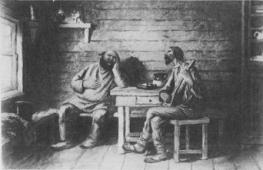Typical test tasks.
USE 2018. Informatics. Typical test tasks. 14 options for tasks.

M.: 2018. - 280 p.
The author of the tasks is a leading specialist who is directly involved in the development of control measuring USE materials. Typical test tasks in informatics contain 14 options for sets of tasks, compiled taking into account all the features and requirements of the Unified state exam in 2018. The purpose of the manual is to provide readers with information about the structure and content of KIM 2018 in computer science, the degree of difficulty of tasks. The collection provides answers to all test options, provides solutions to all tasks of one of the options, as well as solving problems of part 2. The manual is intended for teachers to prepare students for the computer science exam, as well as for high school students for self-training and self-control.
Format: pdf
Size: 5.8 MB
Watch, download:drive.google
CONTENT
Preface 5
Unified state exam in informatics and ICT 6
Work instructions 6
Option 1 10
Part 1 10
Part 2 21
Option 2 25
Part 1 25
Part 2 36
Option 3 41
Part 1 41
Part 2 49
Option 4 51
Part 1 51
Part 2 59
Option 5 63
Part 1 63
Part 2 69
Option 6 72
Part 1 72
Part 2 79
Option 7 82
Part 1 82
Part 2 93
Variant 97
Part 1 97
Part 2 108
Option 9 113
Part 1 113
Part 2 124
Option 10 129
Part 1 129
Part 2 139
Option 11 143
Part 1 143
Part 2 154
Option 12 159
Part 1 159
Part 2 170
Option 13 175
Part 1 175
Part 2 186
Option 14 191
Part 1 191
Part 2 202
Option 1 solutions 207
Part 1 207
Part 2 216
Answers to the tasks of part 1 221
Solving tasks of part 2 222
Option 2 222
Option 3 227
Option 4 230
Option 5 234
Option 6 237
Option 7 241
Option 8 245
Option 9 248
Option 10 253
Option 11 258
Option 12 263
Option 13 268
Option 14 274
The examination paper in informatics and ICT consists of two parts. There are 23 tasks in the first part. All of them require a short answer: in task No. 2 - a string of characters, in other tasks - an unsigned integer. Checking the answers to the tasks of part 1 is carried out automatically: the examiner's answer is compared with the reference answer.
The tasks in the variant are arranged in increasing complexity, so it is recommended to complete them in a row, one after the other. If you find it difficult, you can skip the task and return to it after completing all the tasks that you managed to solve at once.
Approximately 90 minutes are allotted to complete the first part of the exam. Under the conditions of a real exam, which lasts 3 hours 55 minutes, you can spend more time on solving Part 1 tasks, but it should be understood that in this case there may not be time left to solve Part 2 tasks. USE options it is recommended to allocate a double lesson for solving the tasks of part 1, that is, 90 minutes of pure time.
annotation
The authors of the manual are leading experts who are directly involved in the development teaching materials to prepare for the implementation of control measuring materials of the exam. The book contains 50 variants of sets of standard test tasks in mathematics, compiled taking into account all the features and requirements of the Unified State Examination in Mathematics basic level. The purpose of the manual is to provide readers with information about the structure and content of control measuring materials in mathematics, the degree of difficulty of tasks. The collection contains answers to all variants of tests. In addition, examples of forms used in the exam for recording answers and decisions are given. The manual can be used by teachers to prepare students for the exam in mathematics in the form of the Unified State Examination, as well as by high school students for self-training and self-control.
Textbook example
The examination paper includes 20 tasks.
3 hours (180 minutes) are allotted to complete the work.
Answers to tasks are written according to the samples below in the form of a number or a sequence of numbers. First, write down the answers to the tasks in the answer field in the text of the work, and then transfer them to the answer form No. 1 to the right of the number of the corresponding task.
If the answer is a sequence of numbers, as in the example below, then write this sequence in the answer sheet No. 1 without spaces, commas and other additional characters.
All USE forms are filled in with bright black ink. It is allowed to use gel, or capillary, or fountain pens.
When completing assignments, you can use a draft. Draft entries do not count towards the assessment of the work.
The points you get for completed tasks are summed up. Try to complete as many tasks as possible and score the most points.
Work instructions 4
Reference materials 6
Option 1 11
Option 2 16
Option 3 21
Option 4 26
Option 5 31
Option 6 36
Option 7 41
Option 8 46
Option 9 52
Option 10 58
Option 11 63
Option 12 68
Option 13 73
Option 14 78
Option 15 84
Option 16 89
Option 17 94
Option 18 99
Option 19 104
Option 20 109
Option 21 114
Option 22 119
Option 23 124
Option 24 129
Option 25 134
Option 26 139
Option 27 144
Option 28 149
Option 29 154
Option 30 159
Option 31 164
Option 32 169
Option 33 174
Option 34 179
Option 35 184
Option 36 189
Option 37 194
Option 38 199
Option 39 204
Option 40 209
Option 41 214
Option 42 220
Option 43 225
Option 44 230
Option 45 235
Option 46 240
Option 47 245
Option 48 250
Option 49 255
Option 50 260
Answers 266
Also read along with this:



USE 2018. Russian language. Typical test tasks. 14 options for tasks.


M.: 2018. - 136s. M.: 2018. - 256s.
The authors of the assignments are specialists who are directly involved in the development of assignments for the exam. Typical test tasks in the Russian language contain 14 options for sets of tasks, compiled taking into account all the requirements of the Unified State Exam in 2018. The purpose of the manual is to provide readers with complete information about the structure and content of KIM in the Russian language, the degree of difficulty of tasks. The collection contains answers to all test options and provides a detailed explanation of the tasks of one option. In addition, examples of forms used in the exam for recording answers are given. The manual is addressed to high school students for self-training and self-control, as well as teachers to prepare students for the Russian language exam.
Format: pdf format 220x290
Size: 2.6 MB
Watch, download: drive.google
Format: pdf format 130x200
Size: 2.6 MB
Watch, download: drive.google
CONTENT
Work instructions 5
Option 1
Part 1 9
Part 2 24
Option 2
Part 1 25
Part 2 40
Option 3
Part 1 42
Part 2 56
Option 4
Part 1 57
Part 2 72
Option 5
Part 1 74
Part 2 89
Option 6
Part 1 91
Part 2 106
Option 7
Part 1 108
Part 2 123
Option 8
Part 1 125
Part 2 140
Option 9
Part 1 142
Part 2 157
Option 10
Part 1 159
Part 2 173
Option 11
Part 1 175
Part 2 189
Option 12
Part 1 191
Part 2 205
Option 13
Part 1 206
Part 2 221
Option 14
Part 1 222
Part 2 235
Answers 237
Information about texts 242
The examination paper consists of two parts containing 25 tasks. Part 1 contains 24 tasks, part 2 contains one task.
For execution examination work 3.5 hours (210 minutes) are allotted for the Russian language.
The answers to tasks 1-24 are a number (number) or a word (several words), a sequence of numbers (numbers). Write your answer in the answer field in the text of the work, and then transfer it according to the samples below to the answer form No. 1.
Task 25 of part 2 is an essay based on the read text. This task is performed on the answer sheet No. 2.
All USE forms are filled in with bright black ink. You can use a gel, capillary or fountain pen.
When completing assignments, you can use a draft. Draft entries do not count towards the assessment of the work.
The points you get for completed tasks are summed up. Try to complete as many tasks as possible and score the most points.
1. Indicators for assessing the natural illumination of premises are:
a) deepening coefficient;
b) light factor;
c) window size;
d) coefficient of natural illumination;
e) the number of windows.
2. Indicators for assessing the natural illumination of the workplace are:
a) light coefficient;
b) hole angle;
c) coefficient of natural illumination;
d) angle of incidence;
e) penetration factor;
e) the number of windows.
3. Daylight ratio can be determined
a) using a light meter;
b) by calculation;
c) using a light meter and calculation.
4. To assess artificial illumination, a calculation method is used
a) volt; b) watt; c) nit.
5. Normalized KEO in natural overhead lighting:
a) minimum KEO;
b) average KEO.
6. The ratio of the distance from the light-bearing wall to the inner one to the height of the upper edge of the window above the floor is
a) the depth of the room;
b) the depth of the premises.
7. Norms of natural lighting of classrooms (KEO), not less than:
8. Optimal orientation of operating rooms in mid-latitudes:
a) northeast;
b) southeast;
c) southwest.
9. Norms of illumination of working surfaces in classrooms when illuminated with fluorescent lamps:
10. The ability of the visual analyzer to clearly distinguish an object close to the threshold, continuously viewed for a given time, is
a) visual adaptation;
b) speed of discrimination;
11. Visual analyzer fatigue depends on the following lighting characteristics:
a) insufficient lighting;
b) excessive brightness;
c) uneven distribution of brightness on the working surface.
12. The ability of the visual analyzer to perceive the difference of adjacent brightnesses that are minimally different from each other, this
a) contrast sensitivity;
b) speed of discrimination;
c) stability of clear vision.
13. The greater the angle of incidence, the less illumination
14. The ratio of the horizontal illuminance indoors to the simultaneously measured horizontal illuminance outdoors, expressed in % , this
a) natural light factor;
b) light factor.
15. Optimal orientation of classes in middle latitudes:
b) southwest;
a) 1:2-1:6; b) 1:4-1:5; c) 1:8-1:10.
a) no more than 5°;
b) not more than 27°;
c) not less than 27°.
18. Features of local lighting:
a) creation high level illumination on a limited working surface;
b) the possibility of changing the direction of light;
c) the need to take into account the protective angle of the lamp.
19. The ratio of luminous intensity to the area of the luminous surface is called:
a) illumination; b) luminous flux; c) brightness.
20. A possible (approximate) assessment of the sufficiency of daylight in a room is given on the basis of a measurement:
a) light coefficient;
b) coefficient of natural illumination;
c) studies of the physiological functions of vision.
STANDARDS OF CORRECT ANSWERS
The authors of the manual are leading experts who are directly involved in the development of methodological materials for preparing for the implementation of control measuring materials for the exam.
Chapter I of the book contains 36 variants of sets of standard test tasks in mathematics, compiled taking into account all the features and requirements of the Unified State Examination in Mathematics at the profile level of 2018.
Chapter II of the book separately presents qualitative information about the tasks in Part 2 and an extensive selection of problems in Part 2, arranged on all topics of school mathematics.
The purpose of the manual is to provide readers with information about the structure and content of control measuring materials in mathematics at the profile level, the degree of difficulty of tasks.
The collection contains answers to all test options, provides solutions to all tasks of part 2 of two options, as well as answers to all tasks of chapter II, part 2 of the book.
In addition, examples of forms used in the exam for recording answers and decisions are given.
The manual can be used by teachers to prepare students for the exam in mathematics in the form of the Unified State Examination, as well as high school students and graduates - for self-training and self-control.
Examples.
If you mix a 54% acid solution and a 61% solution of the same acid and add 10 kg of pure water, you get a 46% acid solution. If, instead of 10 kg of water, 10 kg of a 50% solution of the same acid were added, then a 56% acid solution would be obtained. How many kilograms of a 54% solution were used to make the mixture?
On January 15, it is planned to take a bank loan for 7 months. The conditions for its return are as follows:
- On the 1st day of each month, the debt increases by 4% compared to the end of the previous month;
- from the 2nd to the 14th day of each month, part of the debt must be paid;
- On the 15th day of each month, the debt must be the same amount less than the debt on the 15th day of the previous month.
What percentage of the loan amount is the total: the amount of money that needs to be paid to the bank for the entire loan period?
Free download e-book in a convenient format, watch and read:
Download the book USE 2018, Mathematics, Profile level, 36 options, Typical test tasks and 800 tasks of part 2, Yashchenko I.V., Volchkevich M.A., Vysotsky I.R. - fileskachat.com, fast and free download.
- USE 2019, Mathematics, Profile level, 50 options, Typical test tasks, Yashchenko I.V., Volchkevich M.A., Vysotsky I.R., Kosukhin O.N., Fedorovykh D.A.
- USE 2019, Mathematics, Profile level, 50 options, Typical test tasks, Yashchenko I.V., Volchkevich M.A., Vysotsky I.R.
- USE 2019, Mathematics, Profile level, 36 options, Yashchenko I.V., Volchkevich M.A., Vysotsky I.R., 2019
- USE 2019, Mathematics, Profile level, 14 options, Typical test tasks, Yashchenko I.V., Volchkevich M.A., Vysotsky I.R.
The following tutorials and books.



